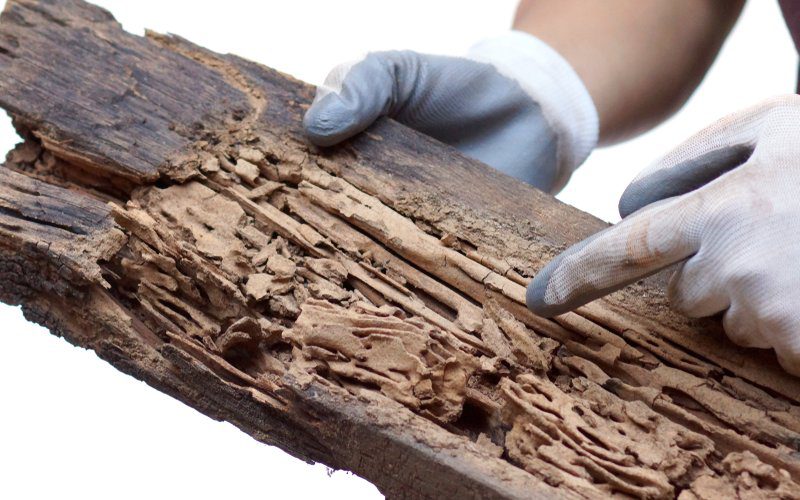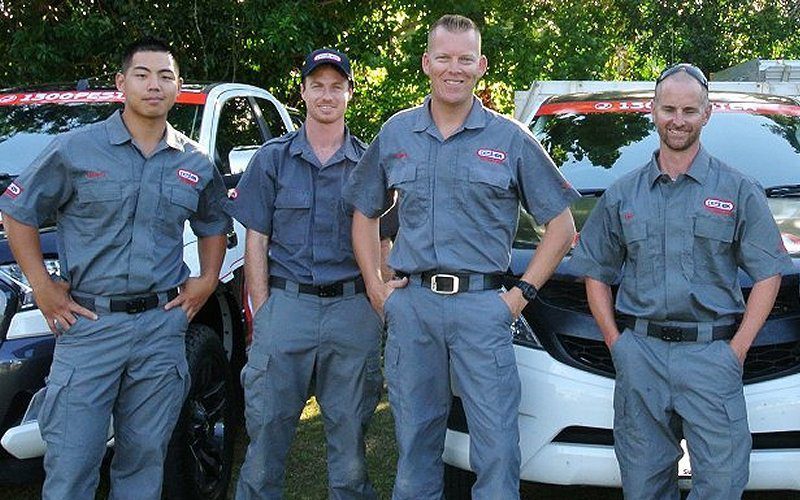
Got a Pest Problem? Call Us Today →

“Our house was built in the 60’s and it’s made of hardwood. We’ve never had any issues with Termites. Is it true that Termites can’t eat hardwood?”
 Michael we hear this myth all the time and it’s simply not true.
Michael we hear this myth all the time and it’s simply not true.When it comes to termites, many homeowners believe that hardwood is safe from these destructive pests. However, this is far from the truth. Termites feed on timber because of the cellulose it contains, which provides them with essential nutrients.
Termites rely on cellulose, found in the fibers of wood, to survive. It is the primary nutrient source for all termite species. Even though hardwood is denser and tougher than softwood, termites can break down its cellulose just as effectively. The myth that hardwood structures are safe from termites is simply not true. In fact, these pests can tunnel into even the toughest timbers and cause severe damage over time.
Termites feed on timber for cellulose, and while some termites will eat away at softer timber because it’s easier for them to digest, the three main termites we typically treat—Schedorhinotermes, Coptotermes, and Nasutitermes—all eat hardwood.
These termite species are typically found in Southeast Queensland and other parts of Australia.
Hardwood is definitely a preferred source of food for the majority of termites. Many customers assume that because their homes are constructed from hardwood they aren’t at risk. This is in direct contrast to what we see daily where termites literally gut houses made of hardwood.
In all honesty, this is nothing more than an old myth that has lasted for years and people just think, “Oh, you can’t even drive a nail into that timber, I don’t know how termites are going to eat it.”
The truth is they do.
They’ll eat it until it’s paper-thin or gone completely.

There is a type of termite called Heterotermes, that are easily identifiable by the mud mounds they make on trees. Heterotermes don’t eat hardwood, they can only digest softwood.
We recently received a call from a customer who had a termites nest on a tree near their backyard. Unfortunately, another pest control company (who were obviously inexperienced) incorrectly identified the Termites as Heterotermes and told her that she wasn’t at risk. The termites were infact a species known as Nasutitermes, which do eat hardwood.
Needless to say, not long after, we were called out only to discover significant structural damage had been done to her home.
In this particular case, the Termites had traveled 100 meters through the park, across the customers’ backyard slab and 3 metres up a brick pier, into a hardwood beam in her roof.
Termites cause significant structural damage if left undetected, but there are early warning signs you can look for. Here are some detailed indicators of termite activity:
Hollow-Sounding Wood: When tapped, infested wood may sound hollow due to termites eating away at the interior.
Mud Tubes: Termites build mud tubes to travel between their colony and food sources. These tubes are often visible along wooden beams, walls, or foundations.
Damage to Wood: Look for visible signs of damage such as grooves, holes, or blistering in the wood surface, indicating termite feeding activity beneath the surface.
Frass (Termite Droppings): Frass, or small wood pellets, may be found near timber, as termites push out undigested wood after eating.
Discarded Wings: When termites swarm to form new colonies, they shed their wings, and discarded wings near windows or doors may be a sign of a nearby infestation.
If you observe any of these signs, it’s important to call a professional for an termite inspection. Termite damage can be extensive, especially in hardwood structures, making early intervention crucial to prevent costly repairs.
When it comes to hardwood specifically, there really isn’t any particular type of hardwood that termites wont eat, Infact when it comes to termite bait stations, they’re typically filled with Tasmanian Oak, which is a hardwood. At the end of the day, Termites will consume hardwood or softwood regardless, therefor its always best to ensure you have your home inspected for termites on a regular basis.
We’ve found most homeowners of hardwood homes are often more complacent about having annual termite inspections performed, simply because they believe they’re at less risk. Infact we’ve seen some homeowners go as long as 5 years between inspections, which often leads to termites going undetected which then of course results in extensive structural damage to the hardwood beams floors, door and trusses.
Termites are fast workers, particularly when they have access to a consistent food source like your home’s timber. They can consume up to 6kg of wood per day in ideal conditions. This means that, depending on the size of the colony, termites could seriously compromise your home’s structural integrity within just a few months.
Once termites invade your hardwood, they may leave the wood severely weakened or paper-thin. Unfortunately, this often goes unnoticed until it’s too late, resulting in expensive repairs.
The speed at which termites eat wood also depends on several factors, such as the size of the colony, environmental conditions, and the availability of food. In humid environments where termites thrive, they may work more quickly. Likewise, homes with untreated wood are more vulnerable to infestation, as termites find it easier to tunnel through untreated timber.
To protect your hardwood from termites, consider the following measures:

Annual inspections prevent termites from nesting undetected for prolonged periods of time, so call us today if you have any concerns. We’ve performed more than 10,000 termite inspections and installed thousands of barriers, ensuring effective, long lasting, protection.
Get in touch today for a no obligation free quote.







